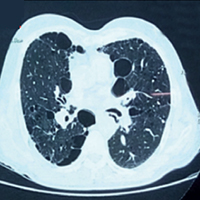Clinico-radiological profile of connective tissue disease related-interstitial lung diseases from a tertiary care centre of India: a cross sectional study

All claims expressed in this article are solely those of the authors and do not necessarily represent those of their affiliated organizations, or those of the publisher, the editors and the reviewers. Any product that may be evaluated in this article or claim that may be made by its manufacturer is not guaranteed or endorsed by the publisher.
Authors
Interstitial lung diseases (ILDs) are a frequently occurring pulmonary manifestation in patients of connective tissue diseases (CTD). Detailed understanding of this subset of lung diseases is vital, hence the study was conducted to analyze the clinico-radiological characteristics of CTD-ILD. The present study was conducted between March 2017 to February 2018 at a tertiary care teaching hospital from western India. A total of 100 patients having respiratory symptoms suggestive of ILD, who were either diagnosed cases of CTD or had clinical manifestations of underlying CTD, were included in the study. 27% of patients belonged to age group 41-50 years and 78% were females. Chief respiratory complaints were dyspnea and cough. Clubbing was present in 29% patients. The most common CTDs were rheumatoid arthritis [RA] (26%), systemic sclerosis [SSC] (21%), mixed connective tissue disorder [MCTD] (19%) and Sjogren’s syndrome [SS] (16%). Restrictive defect on spirometry was seen in 58% cases and was most significant among patients with RA (65%) and SS (62%). Pulmonary arterial hypertension was seen in 40% cases and was most evident in MCTD (78%) and SSC patients (58%). Chest radiograph was normal in 47% of subjects. Most common radiological pattern on high resolution computed tomography (HRCT) thorax was non-specific interstitial pneumonia (42%) followed by usual interstitial pneumonia (21%). ILD is a common manifestation of CTD. Work-up for an underlying CTD should be offered to all ILD patients and vice versa.
How to Cite

This work is licensed under a Creative Commons Attribution-NonCommercial 4.0 International License.






